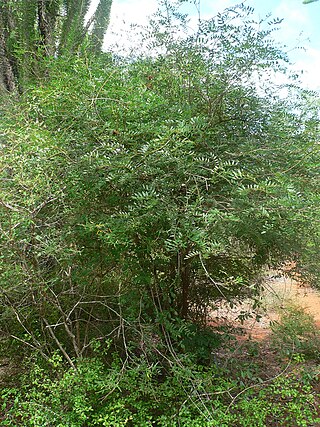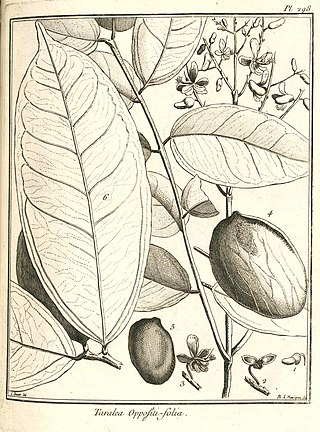
Zollernia is a genus of flowering plants in the legume family, Fabaceae. It includes 10 species native to South America, ranging from Venezuela and the Guianas to southern Brazil. Zollernia are trees or shrubs that flower annually. Species are most commonly found in dense moist forests, but also grow in seasonally-dry cerrado and caatinga.

Xanthocercis is a tree genus in the family Fabaceae. It includes three species native to sub-Saharan Africa.

Dipteryx is a genus containing a number of species of large trees and possibly shrubs. It belongs to the "papilionoid" subfamily – Faboideae – of the family Fabaceae. This genus is native to South and Central America and the Caribbean. Formerly, the related genus Taralea was included in Dipteryx.

Cordyla is a genus of flowering plants in the family Fabaceae. It includes seven species native to sub-Saharan Africa, ranging across northern Africa from Senegal to Somalia, and through eastern Africa from Sudan to KwaZulu-Natal, including Madagascar.

Myrocarpus is a genus of flowering plants in the family Fabaceae. It includes five species of trees native to tropical South America, ranging from Venezuela to northern Argentina. Typical habitats include wet to seasonally-dry tropical lowland forest and woodland.
Orphanodendron is a genus of legume in the legume family, Fabaceae. It includes two species of trees native to Colombia, which grow in tropical lowland forest. The genus is in subfamily Faboideae.

Pericopsis is a genus of flowering plants in the legume family, Fabaceae. It includes four species of trees and shrubs, three native to sub-Saharan Africa and one to Sri Lanka, Malesia, New Guinea, and the Caroline Islands. Typical habitats include tropical lowland forest and seasonally-dry woodland and wooded grassland.

Piliostigma is a genus of flowering plants in the legume family, Fabaceae. It includes five species of small deciduous trees native to sub-Saharan Africa, the Indian subcontinent, Indochina, Java, the Philippines, and northern Australia. It belongs to the subfamily Cercidoideae and the tribe Bauhinieae. It is dioecious, with male and female flowers on separate plants.

Bocoa is a genus of flowering plants in the legume family, Fabaceae (Leguminosae). It belongs to the subfamily Faboideae (Papilionoideae). Several species in the genus were recently reclassified as Trischidium.
Candolleodendron brachystachyum is a species of flowering plant in the legume family, Fabaceae. It belongs to the subfamily Faboideae. It is the only member of the genus Candolleodendron. It is a tree native to the Amazon rain forest of northern Brazil (Pará), Suriname, and French Guiana.
Pterocarpus dubius is a species of flowering plant in the family Fabaceae native to Venezuela, Guyana, and northern Brazil in northern South America.
Fissicalyx fendleri is a species of flowering plant in the legume family, Fabaceae. It is a tree native to the tropical Americas, ranging from Panama through Colombia, Venezuela, and Guyana to northern Brazil. It grows in humid lowland forest.

Hymenolobium is a genus of flowering plants in the family Fabaceae. It includes 14 species of trees native to Central America and northern South America, ranging from Honduras to Bolivia and southeastern Brazil. Most species are native to Brazil, the Guianas, and Venezuela, with one extending into Peru, another into Ecuador, and one native to Central America. Trees are typically very tall and emergent in tropical humid lowland rain forest.

Hypocalyptus is a genus of flowering plants in the family Fabaceae. It includes three species of shrubs, subshrubs or small trees native to the Cape region of South Africa. Typical habitats include Mediterranean-climate shrubland (fynbos) at forest margins, in rocky and sandy areas, and along streams, often at high elevations.
Latrobea is a genus of flowering plants in the legume family, Fabaceae. It includes eight species of shrubs endemic to Southwest Australia. Typical habitats include forest, woodland, and heathland on sandy soils and swampy areas in higher-rainfall areas of the far southwest. The genus belongs to the subfamily Faboideae. The plant is named after Charles Joseph La Trobe.
Monopteryx is a genus of flowering plants in the family Fabaceae. It includes three species of trees native to the Amazon rainforest of northern South America, ranging through parts of Colombia, Venezuela, northern Brazil, and French Guiana. They grow in non-inundated lowland tropical rain forest on sandy soil. The genus belongs to subfamily Faboideae. Members of this genus produce hydroxypipecolic acids in their leaves.

Taralea is a genus of flowering plants in the family Fabaceae. It includes five species of trees and shrubs native to northern South America, ranging from Colombia and Peru to Venezuela, the Guianas, and northern and northeastern Brazil. Habitats include riverine and inundated tropical lowland rain forest, seasonally dry forest, woodland, and marsh. One or two species are also found in montane forest and in open moist woodland and scrub on sandstone-derived soils. It belongs to subfamily Faboideae.
Uleanthus erythrinoides is a species of flowering plant in the family Fabaceae. It is a tree native to northern Brazil. It is the only member of the genus Uleanthus. It belongs to the subfamily Faboideae.
Uribea tamarindoides is a species of flowering plant in the legume family, Fabaceae. It is a tree native to Costa Rica, Panama, and Colombia, where it grows in tropical lowland rain forest. It is the only member of genus Uribea. The genus belongs to subfamily Faboideae.

Pterodon is a genus of flowering plants in the legume family, Fabaceae. It includes four species of trees native to Brazil and Bolivia. Typical habitats include seasonally-dry tropical forest, woodland (cerrado), and thorn shrubland (caatinga), often on rocky outcrops. It belongs to the subfamily Faboideae.











